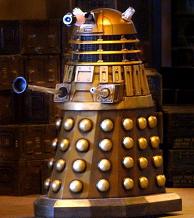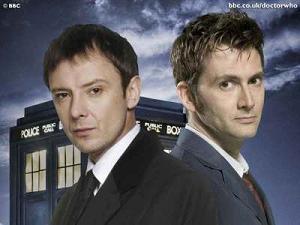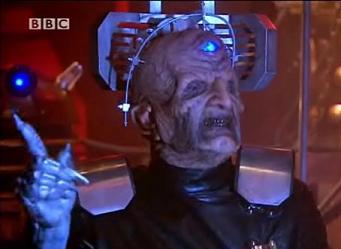Sci-Fi Worlds, for the uninitiated, has its origins in a piece I wrote for Stuart Miller's sadly defunct Alien Worlds magazine. In the piece, I took a look back at the last four years of new Doctor Who on our screens and reflected on its success and the parallels with the real world. Now, of course, not all our readers would have read it. So I thought it might be interesting to do a special new revised edition just for BoA.

After 26 seasons, the original series was axed in 1989, leaving a whole generation of children without their own Doctor and only video releases and UK Gold repeats to fill the void. Then in 2003 (the 40th anniversary year of the series) came the exciting news that the BBC were going to revive Doctor Who. So, four seasons on, how has the new series done?
When fans first heard that Doctor Who was coming back, many were worried that the series would either make the silly mistake of changing too much and alienating the fandom or, more dangerously, changing too little and confusing new viewers. It is often argued that the reason the old series was cancelled in the first place was because it became a fan show bogged down in its own continuity, instead of a family show for everyone. Fortunately, it looks like the new series has somehow managed to walk this tightrope incredibly well, resurrecting old favourites, inventing new ones and adding to the epic mythology of the program instead of becoming trapped by it.
Over the last four years, we've witnessed the return of legendary monsters like the Autons, Daleks and Cybermen; as well as the Doctor's nemesis the Master; and old allies UNIT, Sarah Jane Smith and robot dog K-9. But each time the new series has revived popular elements like these from the Doctor's past, it has done so in a way that both changes them enough to make them relevant to today, while at the same time staying true to the original concept. The program has successfully recycled old Cold War creations for a post 9/11 world and much more technological age.
Perhaps the most obvious example of how the new series has done this has been the reintroduction of the Doctor's greatest foes, the Daleks, to the series. The new metallic bronze design of the Dalek machines stayed true to what a Dalek is and built upon it, when the temptation must have been to totally redesign them. More significantly though, who and what the Daleks are meant to represent seems to have been updated in a similar way.
| 
|
In the original series, Dalek creator Terry Nation made it clear what his steel creations represented. When the Daleks first appeared in 1963, WWII had only been over for 18 years and the memory of the Nazis and their crimes was still very much fresh in people's minds. The links between the Daleks and Hitler's Third Reich were made particularly obvious in the 1964 story The Dalek Invasion of Earth, where the Daleks occupy mid-22nd century Earth. In the story, the Daleks organise (like the Nazis had) slave labour camps, use Nazi terminology like "extermination" and are even seen giving their own version of the Hitler salute. Also, later in the 1975 story Genesis of the Daleks Nation introduced a very Fuhrer-like Davros as their leader.
When they returned in the new series, it was made equally clear what the Daleks were now meant to represent. In a move that both updated the Daleks for modern audiences but also echoed what were probably Nation's original intentions, the Daleks were changed from Nazis to symbols for the new evil fresh in peoples minds: radical religious fundamentalism and terrorism.
This change is probably most prevalent in season one of the new series. For instance, in Dalek we encounter a lone Dalek soldier, who after being tortured by its American captors (in an attempt to quite literally make it talk) escapes and exterminates most of them. And, if the parallels here with the War on Terror and Guantanamo Bay weren't already strong enough, the story ends with the escaped Dalek 'terrorist', in effect, committing suicide by blowing itself up.
Further, in The Parting of the Ways, the Daleks are even openly shown as religious fanatics, not only talking of "blasphemy" for the first time but also showing religious devotion to their Dalek Emperor, going as far as worshiping the mutant monstrosity as the "God of all Daleks."
 |
Much like the Daleks, the Doctor's second most popular enemies, the Cybermen, were similarly updated when they returned in season two of the new series. Originally created in 1966 by the writing team of Dr Kit Pedler and Gerry Davis, the Cybermen made their first appearance in William Hartnell's last story as the Doctor, The Tenth Planet. They went on to make numerous returns in the series, with a decapitated Cyber head even appearing on display in Dalek.
|
Interestingly though, the Cybermen we meet in the new series come from a parallel Earth and have nothing to do with the old series' Cybermen: who originally came from Earth's long lost twin planet Mondas. Despite this change, the new series' Cybermen probably reflect the original premise of their creators better than the old ones ever did. Making it graphically clear who and what they are meant to be... humans who had had their humanity surgically removed and replaced with cold technology.
In the age of the Internet, mobile phones and iPods, where we're all becoming increasingly dependant on technology, this fact is probably more relevant now than ever. It could even be argued that because of our growing obsession with technology, that we're all, in a way, becoming Cybermen ourselves. A point not missed by the new series in Rise of the Cybermen and The Age of Steel, where we see how a parallel Earth's obsession with the latest upgrade eventually leads to the mass conversion of the population into Cybermen.
It would be a big mistake to think the new series writers are afraid to add to the Cyber mythos though. In the 2008 Christmas special, The Next Doctor, they not only continued to stay loyal to the original vision (for instance, having the Cybermen invade London again) but also introduce two new variants of Cybermen: the wraith like cybershades and the powerful CyberKing, a Cyberman Dreadnought style battleship with the capability to convert millions into Cybermen as the steel giant strides through the streets of London.
Another good example, of course, is the Master, who was brought back in season three of the new series. Out of all the Doctor's old enemies to return in the new series, probably none have changed more than the Master. Which is perfectly acceptable, because, like the Doctor, every incarnation of the Master (a fellow Time Lord with 12 regenerations) should be unique. All the key characteristics of the Master are still there, he is still an evil genius and psychopath with dreams of universal dominion, only now instead of simply being a renegade Time Lord ... he's the British Prime Minister and dictator of Earth. Perhaps we should ask if the Master has regenerated into Tony Blair?
|  |
This is a joke of course, but in The Sound of Drums and Last of the Time Lords there is definitely something very reminiscent of Blair's run about the Master's reign. From the music the Master plays during the Toclafane invasion, to the fact that everyone voted for the Master in the first place because what he had to say sounded good at the time and no one can tell you why. Not to mention, both come to power on a wave of unparalleled popularity and both become universally unpopular after an unjust invasion and occupation. Blair invading Iraq and the Master using the Toclafane to conquer Earth.
Perhaps the most interesting change to the Master though has been the character's new sense of humour. Mirroring Tennant's Doctor the new Master jokes and makes light of tense situations, turning one of the Doctor's greatest strengths against him as well as making the parallels between the two more clear. Not only making the Master more accessible to new audiences but also tying in well with the old series, where the Master was often shown to be the Doctor's parallel and where it was even sometimes hinted that the two are somehow mutually dependent on each other. In the old series the Doctor even went as far as saying: "He's a Time Lord. In many ways, we have the same mind".
But if the Master has changed the most, then the villain to change the least has to be Davros in season four's The Stolen Earth and Journey's End. This is excellent because why change such a timeless character that works so well? Perhaps taken this attitude onboard Julian Bleach gives an outstanding performance as the mutant madman which is eerily similar to Michael Wisher's original and best portrayal of the character in Genesis of the Daleks. The problem with Davros in later stories was that he became too prone to ranting hysterically, Bleach takes the character back to Wisher's much softer and more contemplative style of speech which is far more effective and genuinely chilling.
|  |
Interestingly, the Daleks also seem to go back to their roots in the story. Behaving more like Nazis again instead of terrorists: conquering planets, experimenting on prisoners and even going as far as speaking German for the first time.
So four seasons on, the new series has managed to walk the dangerous line between pleasing new audiences and fandom incredibly well. Resurrecting and reinventing old series' favourites for modern times, making them more relevant to today but in a respectful way that echoes the intentions of their original creators. After four successful years, the new series is taking a small break with season five being broadcast in 2010. No doubt it will be equally successful as long as it continues to use this formula. Until then, though, we have the Easter and other specials to look forward to.
Richard Thomas, BoA UK Correspondent and Columnist.

